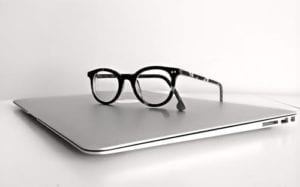Written by Joyce Smith, BS. Study finds that ultraviolet-blocking and blue light-blocking shades are effective in protecting the cells from blue light-induced damage.
 Excessive exposure to artificially emitted blue light at night (visible light with a wavelength of 400-500nm) as in video display terminals (computers, laptops, tablets and smartphones ) may be potentially harmful to our health 1 and lead to circadian rhythm disorders, sleep disorders, mood disorders, carcinogenesis and many other health problems 2. Additionally, blue light may affect vision and the corneal surface of the eye 3. Cell culture studies have described blue light as harmful to ocular surface cells in a dose-dependent manner; however, the protective effect of light-blocking shades has not yet been examined.
Excessive exposure to artificially emitted blue light at night (visible light with a wavelength of 400-500nm) as in video display terminals (computers, laptops, tablets and smartphones ) may be potentially harmful to our health 1 and lead to circadian rhythm disorders, sleep disorders, mood disorders, carcinogenesis and many other health problems 2. Additionally, blue light may affect vision and the corneal surface of the eye 3. Cell culture studies have described blue light as harmful to ocular surface cells in a dose-dependent manner; however, the protective effect of light-blocking shades has not yet been examined.
The purpose of this in vitro study 4 was to examine the phototoxic effect of irradiating the surface (corneal) cells of the human eye with blue light and also to examine the effect of using protective light-blocking shades to protect the eyes from blue light phototoxicity using established primary cultures of human corneal surface cells. The benefits of three light-blocking shades were tested: 1) violet-blocking shade (completely blocking ultraviolet light (UV) and partially blocking visible light around 400-450 nm; 2) blue-plus blocking shade (completely blocks UV light and blocks visible light around 400-450 nm more efficiently than the violet-blocking shade; and 3) a control shade of acrylic polymers.
Primary human cells of corneal surface origin were obtained from eye bank eyes. Using cultured cells, researchers compared the photo protective effect of the three different shades as well as the phototoxic effect on cells irradiated for 3 minutes with blue light. Cell numbers decreased similarly by around 50% compared to the non-irradiated cells. The phototoxicity caused by blue light was not blocked by the control shade, while the violet-blocking shade and the blue-plus-blocking shade both protected the cells from phototoxicity to a lesser or greater extent. The violet-blocking shade resulted in an approximate 30%–40% reduction in viable cells, while the blue-plus-blocking shade resulted in around a 15%–30% reduction. Both indicated a photo protective effect; however, the photo protective effect of the blue-plus-blocking shade was superior to the violet-blocking shade. Previous research has suggested that reactive oxygen species (ROS) is involved in the underlying mechanism by which blue light induces a toxic effect on ocular cells 5.
Study limitations included the use of an in vitro cell culture study which should be further confirmed with long-term clinical or animal studies to better evaluate tissue damage after accumulated toxicity. Various other light spectra should also be examined, including green, yellow and red lights as these are included in the daily environment.
Study results demonstrate that while blue light is harmful to corneal surface cells, both ultraviolet light and blue light blocking shades are effective in protecting these cells from blue light-induced damage. This study is the first to investigate the protective effect of light-blocking shades against blue light phototoxicity in human ocular surface cells, and these results are consistent with previous investigations with retinal cells 6. The authors recommend protection against blue light damage, particularly in high-risk populations such as people with dry eye, contact lens users, the malnourished and the elderly.
Source: Niwano, Yoshimi, Atsuo Iwasawa, Kazuo Tsubota, Masahiko Ayaki, and Kazuno Negishi. “Protective effects of blue light-blocking shades on phototoxicity in human ocular surface cells.” BMJ Open Ophthalmology 4, no. 1 (2019): e000217.
This is an open access article distributed in accordance with the Creative Commons Attribution Non Commercial (CC BY-NC 4.0) license, which permits others to distribute, remix, adapt, build upon this work non-commercially, and license their derivative works on different terms, provided the original work is properly cited, appropriate credit is given, any changes made indicated, and the use is non-commercial. http:// creativecommons. org/ licenses/ by- nc/ 4.0
Click here to read the full text study.
Posted July 29, 2019.
Joyce Smith, BS, is a degreed laboratory technologist. She received her bachelor of arts with a major in Chemistry and a minor in Biology from the University of Saskatchewan and her internship through the University of Saskatchewan College of Medicine and the Royal University Hospital in Saskatoon, Saskatchewan. She currently resides in Bloomingdale, IL.
References:
- Falchi F, Cinzano P, Elvidge CD, Keith DM, Haim A. Limiting the impact of light pollution on human health, environment and stellar visibility. Journal of environmental management. 2011;92(10):2714-2722.
- SCENIHR. Health Effects of Artificial Light. 2012; potential health impacts on the general public caused by artificial light. Available at: http://ec.europa.eu/health/scientific_committees/opinions_layman/artificial-light/en/about-artificial-light.htm#7. Accessed December, 2018.
- Blask D, Brainard G. REPORT 4 OF THE COUNCIL ON SCIENCE AND PUBLIC HEALTH (A-12) AMERICAN MEDICAL ASSOCIATION. 2012.
- Niwano Y, Iwasawa A, Tsubota K, Ayaki M, Negishi K. Protective effects of blue light-blocking shades on phototoxicity in human ocular surface cells. BMJ Open Ophthalmology. 2019;4(1):e000217.
- Lee J-B, Kim S-H, Lee S-C, et al. Blue light–induced oxidative stress in human corneal epithelial cells: protective effects of ethanol extracts of various medicinal plant mixtures. Investigative ophthalmology & visual science. 2014;55(7):4119-4127.
- Narimatsu T, Ozawa Y, Miyake S, et al. Biological effects of blocking blue and other visible light on the mouse retina. Clinical & experimental ophthalmology. 2014;42(6):555-563.
